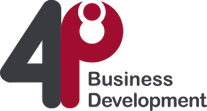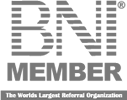Working with the experts …
I work with clients across many varied business sectors, and often uncover issues, and perhaps more importantly, opportunities. So what sort of people do you need to do the same?

An introduction to intellectual property thanks to one of my trusted partners, Wood IP!
copyright: 4p business development
It is my firm belief that you should always use the very best person available to assist you in your business when you need support and advice on a specific area.
Therefore, I have always worked very closely with a bank of trusted partners; people who I know like and trust, and who I believe are amongst the best in their field.
It is increasingly important for any business to protect their brand and with this in mind I have asked Wood IP, the experts in intellectual property, to share some vital information.
What is Intellectual Property?
It is a collection of lots of different rights. Intellectual Property (IP) covers a wide range of parts of your business that have a lot of value and can be the source of a lot of your success.
Things like:
-
Your trading name, product names and domain names (when used or registered)
-
The way your products look
-
Content you create (pictures, articles, etc)
-
Technological advances when recorded and registered as patents
-
Client databases
-
Secret processes
The above translate into Trade Marks, Designs, Copyright, Patents and Trade Secrets. The value of intangible assets (such as Intellectual Property) of a business is increasing over time, with it being estimated that 87% of the total value of businesses in 2015 being made up of intangible assets (Ocean Tomo, LLC).
Why should you take action?
There are three major issues:
-
You may inadvertently (or consciously!) be infringing the rights of another by coming too close to their rights, meaning that you might be vulnerable to legal claims against you
-
Someone else may be getting too close to you (or may plan to) – particularly if you haven’t protected your IP – and you may be powerless to stop it
-
You may be failing to make the most of these potential jewels – not exploiting them on a day-to-day basis, and not identifying them for when you come to sell or value your business. Like any physical asset (like property or machinery) they have a value and once identified and protected there is the same ability to use it yourself, allow others to use it for their purposes or sell it off.
What we often find is that when a business understands its IP, it becomes more successful. Once it knows where the intrinsic value in its business comes from, it can focus on making more of it, putting more into it and becoming even more successful.
What should you do?
The first step is to get IP aware – to identify what IP is used and created by you, to establish which bits might be protectable and to determine whether you are inadvertently breaching someone else’s intellectual property.
You should get an expert in to give the business an ‘audit’. This may reveal areas that require further action, such as protecting your trademarks through registration.
Some IP needs registration via formal procedures, whilst other types do not, and getting an IP strategy in place will give you more peace of mind that you are capturing the full value from your business.
What will it cost?
Like a real property, it depends on what you want, what the audit reveals and your plans for the business. A well-considered report will put a plan in place to fit your budget and pace of growth.
“Would you like to know more about intellectual property?”
For more information on intellectual property and associated issues, or if you feel that your business could do with an IP audit, do contact Aaron Wood and Anna Perry of Wood IP directly on 01327 223555.
Until next time …

KATH BONNER-DUNHAM
|
PS: |
4P Business Development works with a number of trusted partners who are all experts in their field. You will find a list of other trusted partners on my website and I would be happy to introduce you to any of them. |
Will it be different this year?
How often have you began a New Year with all the right intentions only to find that you are doing the exact same things that you have always done, making the same errors and at best standing still …

We all want a successful and profitable 2018, but will it just be more of the same?
copyright: 4p business development
When I am working with clients, so often they say it will be different this year, however, unless you made some fundamental changes and most significant time out to plan, and ensure the right processes are in place, the likelihood is nothing will change.
Now is the time to take a look at my 4 step approach to ensure profitability for the coming year:
-
Reflect
Reflect on the biggest mistakes you made last year and where the most significant lessons are to be found then ask yourself and your team some soul-searching questions.
-
What was the root cause of the biggest issues you faced?
-
What processes could you put in place to prevent these happening again in the future?
-
What were your greatest successes?
-
How can you build on those successes?
-
-
Analyse
Analyse where you can make the greatest difference and increase profitability. Consider this very carefully and decide if the successes generally came from your ‘A Grade’ clients with the headaches, and misery came from the ‘D Grade’ clients.
-
Apply the Pareto Principle or the 80/20 rule
-
Could you business actually be more successful by letting some of your ‘D Grade’ clients go?
-
-
Define
Define the strategic objectives and critical drivers for success and profitability ensuring you cover all operations, sales, and financial KPIs.
-
Consider strategic objectives
-
Re-visit your PR and marketing activity
-
Chose your clients ruthlessly by grading the target market
-
Look at up-selling to your best clients
-
Maintain customer delight
-
-
Set Targets
Set SMART targets: financial and new business acquisition. Use all the tools you have available to you to ensure focused performance from the whole team
-
Revisit the sales process and training
-
Set target based on profitability and not just on number
-
Increase prices wherever possible
-
Hold the whole organisation accountable
-
Know your numbers and keep on top of the profitability of every product and service on at least a monthly basis
-
Is your business stuck in the paradigm, comfortable with ‘the way we do things around here’? Perhaps it’s now time to question the status quo and the paradigm, or cultural web, within your organisation?

The Cultural Web identifies six interrelated elements that help to make up what Johnson and Scholes call the paradigm – the pattern or model – of the work environment. By analysing the factors in each, you can begin to see the bigger picture of your culture: what is working, what isn’t working, and what needs to be changed.
The six elements are:
-
Stories – The past events and people talked about inside and outside the company. Who and what the company chooses to immortalize says a great deal about what it values, and perceives as great behaviour.
-
Rituals and Routines – The daily behaviour and actions of people that signal acceptable behaviour. This determines what is expected to happen in given situations, and what is valued by management.
-
Symbols – The visual representations of the company including logos, how plush the offices are, and the formal or informal dress codes.
-
Organisational Structure – This includes both the structure defined by the organisation chart and the unwritten lines of power and influence that indicate whose contributions are most valued.
-
Control Systems – The ways that the organisation is controlled. These include financial systems, quality systems, and rewards (including the way they are measured and distributed within the organisation).
-
Power Structures – The pockets of real power in the company. This may involve one or two key senior executives, a whole group of executives, or even a department. The key is that these people have the greatest amount of influence on decisions, operations, and strategic direction.
|
|
If you’d like to find out more about anything I’ve mentioned here and help your company achieve a successful and profitable 2018, call me on
01280 700405 or click here to ping me an email and let’s see how I can help you.
Until next time …

KATH BONNER-DUNHAM
|
PS: |
If you’re looking for a partner to help grow your business, visit www.4pbusinessdevelopment.co.uk to discover how 4P Business Development can help you! |
Four ways to motivate your teams …
For most of us, workplace collaboration is an integral part of our day. We get into the office and within minutes people are asking for help and advice face-to-face, over the phone and by email …

If you get your workplace collaboration right, business productivity is always improved!
copyright: 4p business development
The way teams interact and communicate is essential to the smooth running of a business, but did you know there is an entire psychology behind it? And the better you know that psychology, the better you can motivate your team to work together.
“Good communication leads to good collaboration which leads to business success!”
There are many books written on the subject and over the 45 years of my own experience running businesses, I’ve picked up many tips and pointers. Some work well, some not so well, so I’ve distilled what I’ve learned into this useful list:
-
Promote ‘good’ stress for better collaboration
There is a lot of stress out there, and it is perceived by most people as bad. But when it’s managed effectively, it can be a real boost to creativity and improve team engagement.
By limiting ‘hindrance stressors’, your workplace can develop a more autonomous environment where employees feel comfortable sharing ideas and collaborating.
-
Bridge the introvert/extrovert gap
Did you know that 50-75% of the population are classed as extroverts and the rest are introverts? In any team, there will be a mix of both all with different working and communication styles. For example, extroverts like busy, noisy workspaces and introverts don’t.
It’s unlikely you are able to provide every introvert with their own office for a secluded workspace, but you can promote flexible working options using good technology to boost productivity.
-
There is no failure, only feedback
When a company runs on a blame culture, productivity collapses and team communication fails. Regular one-to-one and group assessments are essential. Don’t save everything up for the yearly review and for every negative you want to bring up, make sure you balance that with a positive too!
Working this way means problems can be fixed quickly, and colleagues will form better, more open relationships. And remember, feedback goes up as well as down!
-
Sometimes, let employees’ minds wander
It’s all well and good setting tasks for the individual team members to do each day and ensuring it’s done to schedule, but it’s also good to allow them some time to daydream too.
You’ll be surprised how the brain works when this happens; creativity can be boosted and some great new ideas and innovations can leap from the mind having the freedom to just drift for a while.
The most productive teams have a wide mix of personalities in them and it is up to the leader to ensure everyone is engaged and communicating in the most efficient way.
By understanding how employees are psychologically affected by workplace events and how you can make a positive change, your business and your employee satisfaction will benefit.
“Would you like to know more?”
I have many years experience in the psychology of workplace collaboration and can use these skills to improve employee engagement and communication, which in turn boosts the overall productivity of your business.
Call me on 01280 700405 and let’s see how I can help you.
Until next time …

KATH BONNER-DUNHAM
|
PS: |
If you’re looking for a partner to help grow your business, visit www.4pbusinessdevelopment.co.uk to discover how 4P Business Development can help you! |
Have you promoted the right person?
Have you chosen the right person to promote into management in your business? Research reveals that companies consistently choose the wrong people for management roles …

The Peter Principle says organisations promote employees to positions of incompetence!
copyright: 4p business development
The Peter principle is a concept in management theory formulated by educator Laurence J. Peter and published in 1969. It states that the selection of a candidate for a position is based on the candidate’s performance in their current role, rather than on abilities relevant to the intended position.
“Therefore, employees only stop being promoted once they can no longer perform effectively!
This also means that ‘managers rise to the level of their incompetence’ and it has been noted that about 60% of new managers underperform during their first two years on the job.
Perhaps new managers are not ready for the new roles? Perhaps they do not have the core skills required for the job? Many employees who get promoted to managerial positions get there by doing great work in their existing role, but does that make them fit for being the new manager?
Successful managers wake up day after day entirely committed to succeeding and to moving beyond their comfort zone, despite the fear of doing so.
Here are my top tips for your new managers:
Embrace the change, recognising it is a new job
Develop a professional persona
Set the tone and encourage open communication
Understand the difference between being friendly and being friends
Take on responsibility and be prepared to make difficult decisions
Learn about situation leadership
Disengage from casual conversations with staff members
Focus on the development of the business and the business results
Learn about delegation and how to let go of the detail
Be available and visible
Learn to listen and to ask questions
Understand that you will now need to deal with performance issues
Encourage 1:1 meetings with team members
Learn to be a rule maker
Embrace your role as a leader … it can, and should, be a rewarding responsibility, not to be taken for granted
Perhaps most importantly, ensure that they know they are welcome to ask for and actively engage in ongoing personal development and learn new skills to assist with different management situations.
Dr. Peter explained in his book that an employee’s inability to fulfil the requirements of a given position that they are promoted to may not be the result of general incompetence. It may be due to the fact that the position requires different skills than those the employee actually possesses.
For example, an employee who is very good at following rules or company policies may be promoted into the position of creating rules or policies, despite the fact that being a good rule follower does not mean that an individual is well-suited to be a good rule creator.
A possible solution to the problem posed by the Peter Principle is for companies to provide adequate skill training for employees receiving a promotion. The company must ensure the training is appropriate for the position to which the employee has been promoted.
However, Dr Peter pessimistically predicted that even the best employee training is ultimately unable to overcome the general tendency of organisations to promote employees to positions of incompetence, which he refers to as positions of ‘final placement.’
Make sure you train and coach your employees ready for promotion, and that they have the correct skills to manage, make decisions and to take the business forward.
“Would you like to know more?”
If you’d like to learn more about the Peter Principle or need some help training and coaching your employees, do give me a call on
01280 700405 or click here to ping over an email and let’s see how I can help you.
Until next time …

KATH BONNER-DUNHAM
|
PS: |
If you’re looking for a partner to help grow your business, visit www.4pbusinessdevelopment.co.uk to discover how 4P Business Development can help you! |
Turnover is vanity, profit is sanity, cash is reality …
Listening to the news this past week, more and more businesses, small and large, are in trouble financially. It appears that they have all made one grave error …

If your customer base is growing but your profits are shrinking, you could be in trouble!
copyright: 4p business development
They’ve lost ‘A Grade’ customers and filled the gaps with many more ‘D Grade’ ones instead. Now they’ve got so much to do, they’re working all hours of the day and night, but for very little profit.
“I speak to a lot of business owners and managers!”
Some are new to business, and some very experienced; and I find that many just do not understand their real financial position.
It’s a common phrase: turnover is vanity, profit is sanity, cash is reality. You should be asking yourself these four key questions:
-
How much cash do we have in the bank?
-
What are our debtors and what are our liabilities?
-
What is the cash flow projection of this business?
-
What are my profit margins?
What’s the answer you may ask? Well, it’s not rocket science:
-
Understand your target market
-
Grade your customers A, B, C and D, where A = High Profit and D = Low Profit
-
Increase your prices
-
Reduce your costs
-
Get rid of the “D grade” customers
It is dangerous to believe everything you are told. Contrary to general belief, your customers will not leave you because of the price. The most significant cause of them leaving you is perceived indifference; that they think you do not care enough.
Your customers rely on their emotional experiences with more than any of the traditional factors, according to research by the Peppers & Rogers Group, which showed that:
-
60% of all customers stop dealing with a company because of what they perceive as indifference on the part of salespeople/service person
-
70% of customers leave a company because of poor service, which is usually attributed to a salesperson/service person
-
80% of defecting customers describe themselves as “satisfied” or “very satisfied” just before they leave
-
Customers who feel their salesperson/service person are exceptional are 10 to 15 times more likely to remain loyal.
If you raised your prices by 10% how many customers could you afford to lose, and how much time could you free up to take on more “A Grade” ones?
So now, with thanks to BizBuzz, let’s take a look at the top 7 financial drivers of profit and cashflow:
-
Revenue Growth Percentage
Most people think selling more is the way to fix a cash flow problem. Selling more can actually make cash flow problems worse! When you make a sale you need to ‘fund’ that sale, i.e. you need to pay for the stock/labour to deliver the sale, sometimes well before you’ve been paid by your customer. If you have a cash flow problem prior to sales growth it will get worse if you don’t concentrate on the other ‘drivers’.
-
Price Change Percentage
This means a price increase, decrease, or discount. Many small business owners think they can’t increase prices because they will lose customers. You can’t keep selling at the same price for years, absorbing increased costs, and be profitable. Most people understand prices go up. Wages and fuel go up constantly. You must monitor margins to see when it’s time to increase prices.
It’s reasonable to factor a small, regular increase into contracts. Use the opportunity of supplier increases to pass it on to customers. You don’t have to advertise that you’ve increased prices. CPI ranges around 2-3% and is hardly noticeable. If you don’t increase prices regularly, you will notice it when gross profit has reduced by 10% after years selling at the same price.
-
Cost of Goods (COGs) Percentage
This ‘driver’ is probably the most impactful. A small change here can have as much impact as a large increase in revenue. When you sell more, you incur more costs, stock, customers time to pay and jobs in progress prior to invoicing. When you reduce COGs it goes straight to your bottom line! I would recommend putting aside time to focus attention on reducing COGs and achieving efficiencies.
-
Overheads Percentage
Overheads are different to COGs as they occur all the time, e.g. rent, wages etc. COGs generally occur when you sell something, like a product or service. Overheads can ‘eat away’ at profitability if not kept in check. There’s one word for the solution here ‘budget’. There’s no better control than to put a budget into your accounting system and report every month on actual versus budget.
You can quickly identify issues and fix them to save yourself thousands of dollars rather than leaving it to the end of financial year, for tax accounts.
-
Accounts Receivable Days
This is the number of days ‘on average’ customers are taking to pay, if offered credit terms. This is different from the terms offered, e.g. 30 days. It’s not uncommon to see this result up to 120 days. There are many ways to get customers to pay on time, and regular efficient follow-ups is one.
-
Accounts Payable Days
This is the number of days ‘on average’ taken to pay suppliers, if terms are given. It’s common to see this number at less than the Accounts Receivable Days number. This means suppliers are paid quicker than collections from customers.
Not many people like chasing money, but are easily prodded into paying before terms allow. In this scenario, cash is going out to suppliers faster than it’s coming in from customers. The result? A cash squeeze!
-
Inventory and Work in Progress Days
Inventory Days is the number of days ‘on average’ stock sits in stock waiting to be sold. Work in Progress Days is the number of days jobs are in progress prior to invoicing.
Think of stock as dollar bills piled up on the stockroom floor, and Work in Progress as dollar bills piled up on the workroom floor! You need to have stock ready to sell when customers are ready to buy, but not for too long as it sucks up working capital. Sales forecasts and managing customer requirements are one way to minimise Inventory Days.
Work in Progress is made up of wages paid to staff/contract labour and materials on jobs. The longer it takes to complete jobs and then invoice, the more working capital is needed. Speeding up job management and reducing Work in Progress days will have a positive impact on cash. A great way to speed up jobs is to use systems, checklists and templates ensuring consistent quality. These tools reduce mistakes and wasted time. Improved Customer Satisfaction also speeds up payment.
Remember, turnover is vanity, profit is sanity, cash is reality so if you’re finding your profit shrinking as your customer base grows, call me on
01280 700405 or click here to ping me an email and let’s see how I can help you.
Until next time …

KATH BONNER-DUNHAM
|
PS: |
If you’re looking for a partner to help grow your business, visit www.4pbusinessdevelopment.co.uk to discover how 4P Business Development can help you! |














